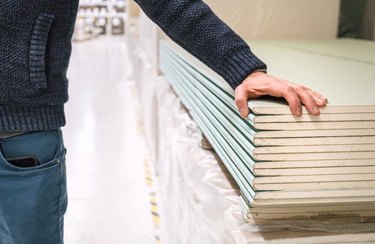
Terms like blue board and green board might be common in construction-speak, but if you plan to remodel your home, understanding the differences between veneer plaster walls and drywall — whether it's green drywall or another variety — is essential.
Blue Board and Veneer Plaster Walls
Video of the Day
While most of the country now uses drywall in typical home construction, plaster walls are still found in older homes that were constructed before this building staple became widely available in the mid-20th century. In the northeastern states, plastering over blue board walls is still common, although this effect is now produced by skimming a thin coat of plaster veneer over a gypsum panel coated with a blue hued paper that is designed to form a strong bond with the layer of plaster. This newer system of plastering walls was developed in the 1960s.
Video of the Day
Blue board is the slang term that refers to the sheet of plasterboard that will serve as a base for the plaster veneer. While it is still a gypsum sheet similar to drywall, the makeup of the board and the paper covering is different, because a wet plaster veneer is applied over its entire surface. This application creates a thin, smooth plaster wall. Although veneer plaster walls are more durable than drywall and less likely to nick or scratch, the cost is often higher than that of standard drywall.
If blue board is what you need, Sheetrock (from USG) and Toughrock (from Georgia Pacific) both offer gypsum plaster base panels with a noncombustible gypsum core that can be used in fire-rated wall systems. If veneer-plastered walls are the finish you want, you might want to consider consulting a professional, as the installation process is fast-paced and requires training and skill.
Green Board and Drywall Walls
Drywall, a gypsum-core panel with paper facing that attaches to wall studs, was developed by USG in the early 1900s, and became the preferred wall material across much of the nation after World War II. Today, there are many specific types of drywall, including standard types, those that are fire resistant or sound resistant, along with types that are mold and moisture resistant.
Drywall is slightly different from plaster base panels, and not just in color. Unlike plaster base panels, which need to be coated in plaster veneer before painting, the drywall surface is ready to accept paint. It is only coated at the seams with a joint compound. The seams are then covered with a drywall tape, mudded once more, and sanded smooth once dry. This process is more time consuming than veneer plastering, but drywall installation is a more cost-effective method and an easier DIY project for homeowners with the right tools.
While standard drywall is the gray hue you are probably familiar with, some specialty drywall is known by its color, much like blue board. Green board is a term used for mold-resistant drywall that is common in bathrooms and other moisture prone places. Green board has a treated core with no paper backing, but has instead a special moisture-resistant coating. Green board is slightly more expensive than standard drywall and requires a specific mold-resistant joint compound.
Purple Board Benefits
Purple board is a type of drywall commonly referred to by its color. Even more expensive than green board, purple board is known to not only prevent mold and mildew, but also to be more durable, withstanding scratches and dents, making it a great selection for high traffic areas like kitchens and mudrooms.